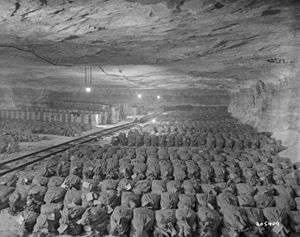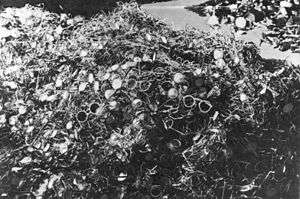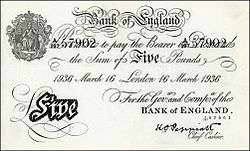Nazi gold
Nazi gold (German: Raubgold, "stolen gold") is the rumored gold allegedly transferred by Nazi Germany to overseas banks during World War II. The regime is believed to have executed a policy of looting the assets of its victims to finance the war, collecting the looted assets in central depositories. The occasional transfer of gold in return for currency took place in collusion with many individual collaborative institutions. The precise identities of those institutions, as well as the exact extent of the transactions, remain unclear.
The present whereabouts of Nazi gold that disappeared into European banking institutions in 1945 has been the subject of several books, conspiracy theories, and a failed civil suit brought in January 2000 against the Vatican Bank, the Franciscan Order, and other defendants.
Acquisition



The draining of Germany's gold and foreign exchange reserves inhibited the acquisition of materiel, and the Nazi economy, focused on militarisation, could not afford to deplete the means to procure foreign machinery and parts. Nonetheless, towards the end of the 1930s, Germany's foreign reserves were unsustainably low. By 1939, Germany had defaulted upon its foreign loans and most of its trade relied upon command economy barter.[1]
However, this tendency towards autarkic conservation of foreign reserves concealed a trend of expanding official reserves, which occurred through looting assets from annexed Austria, occupied Czechoslovakia, and Nazi-governed Danzig.[2] It is believed that these three sources boosted German official gold reserves by US $71m between 1937 and 1939.[2] To mask the acquisition, the Reichsbank understated its official reserves in 1939 by $40m relative to the Bank of England's estimates.[2]
During the war, Nazi Germany continued the practice on a much larger scale. Germany expropriated some $550m in gold from foreign governments, including $223m from Belgium and $193m from the Netherlands.[2] These figures do not include gold and other instruments stolen from private citizens or companies. The total value of all assets allegedly stolen by Nazi Germany remains uncertain.
Discovery, Merkers Mine
Advancing north from Frankfurt, the US 3rd Army cut into the future Soviet zone when it occupied the western tip of Thuringia. On 4 April, the 90th Infantry Division took Merkers, a few miles inside the border in Thuringia. On the morning of the 6th, two military policemen, Pfc. Clyde Harmon and Pfc. Anthony Kline, enforcing the customary orders against civilian circulation, stopped two women on a road outside Merkers. Since both were French displaced persons and one was pregnant, the MPs decided rather than to arrest them to escort them back into the town. On the way, as they passed the entrance to the Kaiseroda salt mine in Merkers, the women talked about gold that the Germans had stored in the mine. By noon the story had passed from the MP first sergeant to the chief of staff and on to the division's G-5 officer, Lt. Col. William A. Russell, who in a few hours had the news confirmed by other DPs and by a British sergeant who had been employed in the mine as a prisoner of war and had helped unload the gold. Russell also turned up an assistant director of the National Galleries in Berlin who admitted he was in Merkers to care for paintings stored in the mine.
The next day was Sunday. In the morning, while Colonel Bernard D. Bernstein, Deputy Chief, Financial Branch, G-5, SHAEF, read about the find[3] in the Stars and Stripes's Paris edition,[4] 90th Infantry Division engineers blasted a hole in the vault wall to reveal on the other side a room 75 feet wide and 150 feet deep.
On Sunday afternoon, Bernstein, after verifying to the fullest the newspaper story with Lt. Col. R. Tupper Barrett, Chief, Financial Branch, G-5, 12th Army Group, flew to SHAEF Forward at Rheims where he spent the night, it being too late by then to fly into Germany. At noon on Monday, he arrived at Gen. George S. Patton's Third Army Headquarters with instructions from Eisenhower to check the contents of the mine and arrange to have the treasure taken away. While he was there, orders arrived for him to locate a depository farther back in the SHAEF zone and supervise the moving. [Under the Big Three arrangements, this part of Germany containing Merkers would be taken over by the Soviets for military government control after the fighting ended.[3]] Bernstein and Barrett spent Tuesday looking for a site and finally settled on the Reichsbank building in Frankfurt.
Disposal
The present whereabouts of the Nazi gold that disappeared into European banking institutions in 1945 has been the subject of several books, conspiracy theories, and a civil suit brought in January 2000 in California against the Vatican Bank, the Franciscan Order and other defendants.[5] The suit against the Vatican Bank did not claim that the gold was then in its possession and has since been dismissed.[6][7]
The Swiss National Bank, the largest gold distribution centre in continental Europe before the war, was the logical venue through which Nazi Germany could dispose of its gold.[8] During the war, the SNB received $440m in gold from Nazi sources, of which $316m is estimated to have been looted.[9]
Vatican
On October 21, 1946, the U.S. State Department received a Top Secret report from US Treasury Agent Emerson Bigelow.[10][11] The report established that Bigelow received reliable information on the matter from the American Office of Strategic Services (OSS) or CIC intelligence officials of the US Army.[12] The document, referred to as the "Bigelow Report" (oftentimes as the Bigelow dispatch, or Bigelow memo) was declassified on December 31, 1996, and released in 1997.[13]
The report asserted that in 1945, the Vatican had confiscated 350 million Swiss francs in Nazi gold for "safekeeping," of which 150 million Swiss francs had been impounded by British authorities at the Austro-Swiss border. The report also stated that the balance of the gold was held in one of the Vatican’s numbered Swiss bank accounts. Intelligence reports, which corroborated the Bigelow Report, also suggested that more than 200 million Swiss francs, a sum largely in gold coins, were eventually transferred to Vatican City or to the Institute for Works of Religion (aka the Vatican Bank), with the assistance of Roman Catholic clergy and the Franciscan Order.[14][15][16]
Such claims, however, are denied by the Vatican Bank. "There is no basis in reality to the [Bigelow] report", said Vatican spokesman Joaquin Navarro-Valls, as reported in Time magazine.[17]
Portugal

During the war, Portugal, with neutral status, was one of the centres of tungsten production and sold to both Allied and Axis powers. Tungsten is a critical metal for armaments, especially for armour-piercing bullets and shells. Much of the Axis tungsten was purchased with Nazi gold bullion, which was looted from the countries they had invaded as well as their dead victims. It is estimated that nearly 100 tons of Nazi gold were laundered through Swiss banks, with only four tons being returned at the end of the war.[18]
During the war, Portugal was the second largest recipient of Nazi gold, after Switzerland; this came through the sale of tungsten, with the German armaments industry nearly entirely dependent on the supplies from Portugal.[19] Initially the Nazi trade with Portugal was in hard currency, but in 1941 the central Bank of Portugal established that much of this was counterfeit and Portuguese leader António de Oliveira Salazar demanded all further payments in gold.[20] Presumably the counterfeit currency were the infamous banknotes produced by Sachsenhausen concentration camp victims in Operation Bernhard.
See also
- 2012 Munich artworks discovery
- August Frank memorandum
- Chiemsee Cauldron
- Gold laundering
- Lake Toplitz
- List of missing treasure
- Moscow gold
- Romanian Treasure, the Romanian gold reserves sent (alongside other valuable objects) to Russia for safekeeping during World War One, but never returned.
- Montagu Norman
- Nazi loot
- Tripartite Commission for the Restitution of Monetary Gold
Notes
- ↑ Medlicott, William (1978). The Economic Blockade (Revised ed.). London: HMSO. pp. 25–36.
- 1 2 3 4 UK Treasury correspondence, T 236/931.
- 1 2 McKinzie, Richard D. (23 July 1975). "Oral History Interview with Bernard Bernstein, July 23, 1975". Harry S. Truman Library. Retrieved 11 November 2012.
- ↑ Stars and Stripes (newspaper), Paris edition, printed at the New York Herald Tribune plant
- ↑ Text of the Civil Action of January 21, 2000: Factual Allegations, nos. 25 – 38.
- ↑ "United States Court of Appeals for the Ninth Circuit" (PDF). Retrieved 2014-07-28.
- ↑ "Slovodna Dalmacija". Slobodnadalmacija.hr. Retrieved 2014-07-28.
- ↑ Eizenstat Special Briefing on Nazi Gold. Stuart Eizenstat, US State Department, 2 June 1998. Retrieved on 5 July 2006.
- ↑ ""Switzerland and Gold Transactions in the Second World War"" (PDF). (1.18 MB). Bergier Commission, May 1998. Retrieved on 5 July 2006.
- ↑ "CNN:"Vatican drawn into scandal over Nazi-era gold"". July 22, 1997.
- ↑ "Inquiry Into Vatican Link to Looted Gold," The Guardian, July 23, 1997, p. 11
- ↑ Aarons, Mark; Loftus, John (1992). Unholy Trinity: How the Vatican's Nazi Networks Betrayed Western Intelligence to the Soviets (revised, 1993 ed.). New York: St.Martin's Press. p. 297. ISBN 0-312-09407-8.
- ↑ "U.S. Document Links Vatican, Nazi Gold.— Tyler Marshall, Times Staff Writer, Los Angeles Times, July 23, 1997".
- ↑ Paris, Edmond; Perkins, Lois (1961). Genocide in Satellite Croatia 1941-1945: A Record of Racial and Religious Persecutions and Massacres (reissued, 1990 ed.). The American Institute for Balkan Affairs. p. 306. ASIN B0007DWXR8
- ↑ Aarons, Mark; Loftus, John (1993). Unholy Trinity: How the Vatican's Nazi Networks Betrayed Western Intelligence to the Soviets (Revised ed.). New York: St.Martin's Press. pp. (432 pages). ISBN 0-312-09407-8.
- ↑ Manhattan, Avro (1986). The Vatican's Holocaust: The Sensational Account of the Most Horrifying Religious Massacre of the 20th Century (1988, paperback ed.). Ozark Books. pp. 237 total. ASIN B000KOOLWE
- ↑ "The Vatican Pipeline by Frank Pellegrini". Time. July 22, 1997.
- ↑ Simons, Marlise (10 January 1997). "Nazi Gold and Portugal's Murky Role". New York Times. Retrieved 1 June 2011.
- ↑ Gonçalves, Eduardo (2 April 2000). "Britain allowed Portugal to keep Nazi gold". The Observer. Retrieved 6 June 2011.
- ↑ Lochery, Neill (17 May 2011). "Portugal's Golden Dilemma". Wall Street Journal. Retrieved 6 June 2011.
References
- Aarons, Mark; Loftus, John (1992). Unholy Trinity: How the Vatican's Nazi Networks Betrayed Western Intelligence to the Soviets (revised, 1993 ed.). New York: St.Martin's Press. p. 297. ISBN 0-312-09407-8.
- Manhattan, Avro (1986). The Vatican's Holocaust: The Sensational Account of the Most Horrifying Religious Massacre of the 20th Century (1988, paperback ed.). Ozark Books. pp. 237 total. ASIN B000KOOLWE
- Paris, Edmond; Perkins, Lois (1961). Genocide in Satellite Croatia 1941-1945: A Record of Racial and Religious Persecutions and Massacres (reissued, 1990 ed.). The American Institute for Balkan Affairs. p. 306. ASIN B0007DWXR8
Further reading
- Alford, Kenneth D.; Savas, Theodore P. (2002). Nazi Millionaires: The Allied Search for Hidden SS Gold (1st ed.). Casemate Publishers and Book Distributors. ISBN 0-9711709-6-7.
- Bradsher, Greg (1999). "Nazi Gold: The Merkers Mine Treasure" in Quarterly of the National Archives and Records Administration, Prologue Page, Spring 1999, vol. 31, no. 1
- Infield, Glenn (1981). The Secrets of the SS (reissued, 1994 ed.). New York: Stein and Day. p. 288. ISBN 0-515-10246-6.
- Sayer, Ian (1984). Nazi Gold: The Story of the World's Greatest Robbery - And Its Aftermath (co-author Douglas Botting with the London Sunday Times). Granada. ISBN 0-246-11767-2.
- Taber, George M. (2014). Chasing Gold: The Incredible Story of How the Nazis Stole Europe's Bullion. Pegasus. ISBN 9781605986555
- Vincent, Isabel (1997). Hitler's Silent Partners: Swiss Banks, Nazi Gold, and the Pursuit of Justice. New York: William Morrow. ISBN 9780688154257
- Wechsberg, Joseph; Wiesenthal, Simon (1967). The Murderers Among Us: The Simon Wiesenthal Memoirs. New York: McGraw-Hill. p. 335. LCN 67-13204. ASIN B000OL6LK8
- Yeadon, Glen (2008). The Nazi Hydra in America. Progressive Press. p. 700. ISBN 0-930852-43-5.
External links
- Nazi Gold and Art -- from Hitler's Third Reich and World War II in the News
- Swiss gold holdings and transactions during WW2
- PBS Frontline: Nazi Gold
- Report of the Swiss Bergier Commission
- Nazi Gold Report (Stuart Eizenstat, Under Secretary for Economic, Business, and Agricultural Affairs, on-the-record briefing upon release of U.S. and Allied Wartime and Postwar Relations and Negotiations With Argentina, Portugal, Spain, Sweden, and Turkey on Looted Gold and German External Assets and U.S. Concerns About the Fate of the Wartime Ustasha Treasury, Washington, DC, June 2, 1998)
- (U.S. News & World Report) "A vow of silence. Did gold stolen by Croatian fascists reach the Vatican?" 30n March 1998
- Lawsuit against Vatican Bank to recover Second World War era gold
- Law-Related Resources on Nazi Gold and Other Holocaust Assets, Swiss Banks during World War II, and Dormant Accounts
- Nazi Gold: The Merkers Mine Treasure
- Bank of England role in selling Nazi gold looted from Czechoslovakia